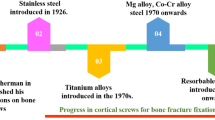Abstract
The use of polymeric bioresorbable type devices as fracture repairs is becoming increasingly common, in part due to the great advantages that they present compared with metal implants in not requiring a second surgery for removal. Pins of poly(l-co-d,l lactide-co-trimethylene carbonate acid), PLDLA-TMC containing 30% TMC were obtained and characterized by in vitro and in vivo study, targeting them for use as fracture devices. Pins 2.5 mm in diameter were obtained by melting the polymer and immersing it in phosphate buffer, pH 7.4 at 37 °C to study the in vitro degradation, in addition to being implanted in the tibia of Wistar rats to assess the bone formation after 15, 60, 90, 120, and 150 days. The results from this study showed that for PLDLA-TMC pins, the thermal, mechanical, and morphological properties remained essentially unchanged after 90 days, particularly the glass transition temperature, Young’s modulus, maximum stress in stretching, and mass loss, in spite of the sharp change in molar mass at the beginning of the degradation process. These results corroborate the in vivo study, which showed the occurrence of bone formation in the early days, especially at 60 and 90 days, and the implant group, in general, presented a more mature and organized bone formation, with less fibrosis than the control group. This set of results indicates that the material has the potential to be applied as a device for the recovery of bone lesions in situations where the permanence of the implant over a long period is essential.












Similar content being viewed by others
References
Albertsson A, Eklund M (1995) Influence of molecular structure on the degradation mechanism of degradable polymers: in vitro degradation of poly(trimethylene carbonate), poly(trimethylene carbonate-co-caprolactone), and poly(adipic anhydride). J Appl Polym Sci 57:87–103
Gartner LP, Hiatt JL (2012) Histologia essencial. Elsevier, Amsterdam
Guarniero R, Cinagava MY, Santana PJ, Batista MA, Oliveira LAA, Rodrigues CJ, Cinavaga FT (2003) Influence of the protein component upon fracture healing: an experimental study in rats. Acta Ortop Bras 11(4):206–210
Han Y, Fan Z, Lu Z, Zhang Y, Li S (2012) In vitro degradation of poly[(l-lactide)-co-(trimethylene carbonate)] copolymers and a composite with poly[(l-lactide)-co-(glycolide) fibers as cardiovascular stent material. Macromol Mater Eng 297:128–135
Hench LL, Ethridge EC (1982) Biomaterials: an interfacial approach. Academic Press, New York
Kfuri JF, Paccola AJ, Chierice GO, Shimano AC (2001) Comparison between absorbable polyparadioxanone and castor oil polyurethane pins in the fixation of distal femur osteotomies in rabbits. Rev Bras Ortop 36(4):121–131
Li SM, Garreau H, Vert M (1990) Structure property relationships in the case of massive aliphatic poly-(a-hydroxy acids) in aqueous-media. Part 1. Poly(dl-lactic acid). J Mater Sci Mater Med 1:123–130
Motta AC, Duek EAR (2014) Synthesis and characterization of a novel terpolymer based on l-lactide, d,l-lactide and trimethylene carbonate. Mater Res 17:619–626
Motta AC (2007) Synthesis and characterization of poly(l-co-d,l lactic acid): study degradation in vitro and in vivo. Doctoral thesis, Unicamp
Motta AC, Duek EAR (2009) Estudo inicial da Degradação “in vivo” de poli (l-co-d,l ácido lático), sintetizado em laboratório, aplicado como prótese tibial em coelhos. Revista Matéria 14(3):1070–1075
Nielsen LE (1974) Mechanical properties of polymers and composites. Marcel Dekker, Inc, New York, p 235
Ohashi H, Kobayashi A, Kadoya Y, Yamano Y, Oonishi H, Iwaki H (2000) Effect of particles and interfaces conditions on fibrous tissue interposition between bone and implant. A particle challenge model in rabbit. J Mater Sci Mater Med 11:255–259
Pego AP, Siebum B, Grijpma D (2003) Preparation of degradable porous structures based on 1,3-trimethylene carbonate and d,l lactide (co) polymers for heart tissue engineering. Tissue Eng 9:981–993
Shyamroy S (2003) Synthesis of biodegradable poly(lactic acid) polymers. Doctoral dissertation, University of Poona, India
Tatum SA, Kellman RM, Freije JE (1997) Maxillofacial fixation with absorbable miniplates: computed tomographic follow-up. J Craniofac Surg 8:135–140
Watanabe J, Amemori S, Akashi M (2008) Disparate polymerization facilitates the synthesis of versatile block copolymers from poly(trimethylene carbonate). Polymer 49:3709–3715
Wu W, Zhou J, Xu C, Zhang J, Jiao Y, Lin S (2014) Biomechanical evaluation of maxillary Lefort I fracture with bioabsorbable osteosynthesis internal fixation. Dent Traumatol 30:447–454
Zhang Z, Kuijerb R, Bulstrab SK, Grijpmaa DW, Feijen J (2006) The in vivo and in vitro degradation behavior of poly(trimethylene carbonate). Biomaterials 27(9):1741–1748
Author information
Authors and Affiliations
Corresponding author
Rights and permissions
About this article
Cite this article
Motta, A.C., de Miranda Fedrizzi, V., Barbo, M.L.P. et al. In vitro and in vivo studies on devices of poly(l-co-d,l lactic acid)-co-TMC for bone repair. Polym. Bull. 75, 4515–4529 (2018). https://doi.org/10.1007/s00289-018-2283-4
Received:
Revised:
Accepted:
Published:
Issue Date:
DOI: https://doi.org/10.1007/s00289-018-2283-4




